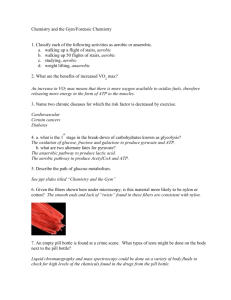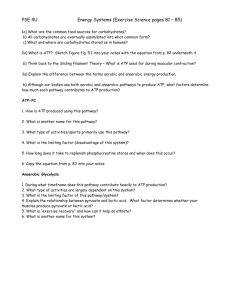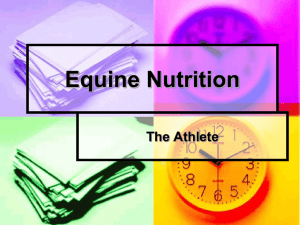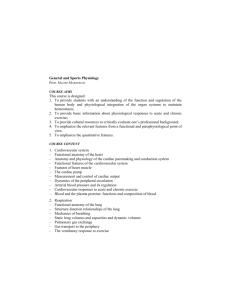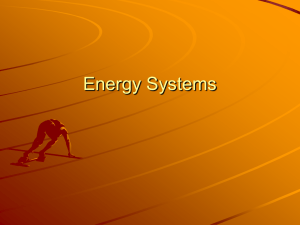Core 2 Training and performance PowerPoint
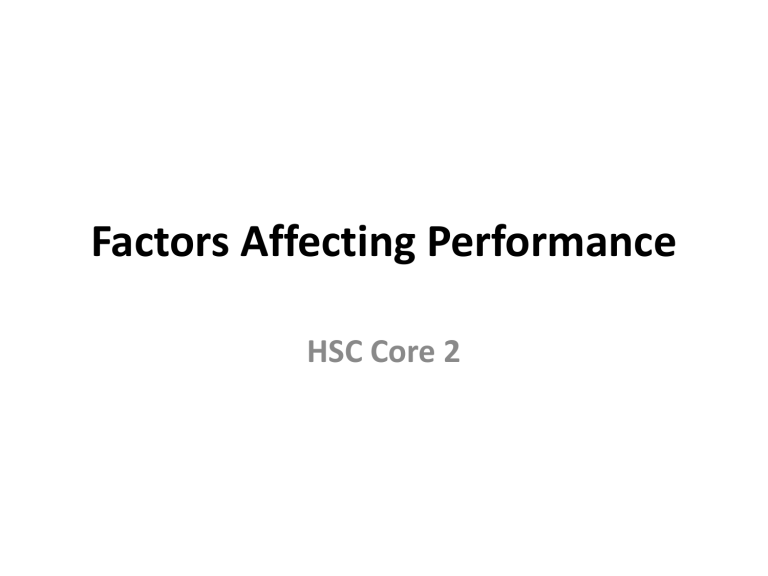
Factors Affecting Performance
HSC Core 2
How does training affect performance?
• Energy systems
– Energy is produced by the breakdown of adenosine triphosphate (ATP) to adenosine diphosphate (ADP) and inorganic phosphate (Pi). Muscle cells can only store limited amounts of ATP, so must also be able to replenish it.
– When ADP combines with creatine phosphate (PC), more ATP is produced.
If this occurs in the absence of oxygen it is referred to as anaerobic metabolism.
– If it occurs in the presence of oxygen it is referred to as aerobic metabolism.
– This cycle of energy breakdown and production continues, providing the amount of energy required at any given time. The energy needed depends on the intensity and duration of the activity.
• The body has three energy systems that rebuild ATP:
1. the alactacid or ATP/PC system
2. the lactic acid or glycolytic system
3. the aerobic or oxidative system.
The three energy systems
Alactacid system (ATP/PC)
• The alactacid system is the quickest way to produce ATP, and is predominantly used for short-duration, high-intensity activities such as diving, long jump and sprints.
• This system also supplies ATP at the beginning of any form of exercise, regardless of intensity, as it can perform without oxygen.
• There are only limited stores of ATP
(approximately 80 grams) and PC (approximately
120 grams) within muscle cells, these are depleted within 6–8 seconds of maximal work.
• If maximal exercise lasts longer than this, assistance from other energy systems is required.
• Therefore a 100-metre sprint is fuelled by both the alactacid and lactic acid energy systems. ATP and PC levels reach approximately 50 per cent after 30 seconds of rest, and are fully restored within 2–5 minutes.
The alactacid energy system
Lactic acid system
• When PC stores have been depleted (after approximately 8 seconds of maximal effort), the lactic acid energy system becomes the dominant supplier of ATP.
• This coincides with a decrease in maximal power output or running speed.
• At about 45 seconds there will be another decline in power output as the body becomes more reliant on the aerobic system for energy
The conversion of lactate to glucose
An athlete predominantly uses the lactic acid energy system when competing in the 400 metres
• The lactic acid energy system relies on a type of glycolysis called anaerobic glycolysis (often referred to as fast glycolysis) to produce ATP.
• The increased concentration of lactate during moderate exercise can be converted to pyruvate and used to synthesise glucose in the liver.
• This new glucose can then be used as an energy source during exercise.
• Therefore lactate is a potential source of energy, and can delay the decrease in blood glucose levels.
Aerobic system
• The aerobic energy system is the most complex of the three energy systems.
• It is the primary source of ATP at rest and during low-intensity exercise.
• Carbohydrates, fats and proteins are used as fuel sources.
• Energy release from fats is very slow, it must be converted from triglycerides into glycerol and free fatty acids.
• Although 1 gram of fat produces more energy than carbohydrates (9 kilocalories from fat, versus 4 kilocalories from carbohydrates), it requires more oxygen.
• As exercise intensity increases there is a greater reliance on
ATP production from glucose (energy is released much quicker) and less on fats.
• Aerobic glycolysis (or slow glycolysis) is used to produce this
ATP.
• This process involves the partial breakdown of glycogen or glucose in the presence of oxygen to produce ATP, with pyruvate as the end product.
• The longer the duration of continuous exercise—more than 1 hour of continuous exercise, or more than 3 hours of intermittent exercise—the more important fat will be as a fuel source, as glycogen stores become depleted.
With training, the body learns to use a combination of glycogen and fats as fuel during competition (such as a marathon) so there is glycogen available at the end of the race to ‘sprint’ home.
The amount of energy stored in the human body
After 1 hour of submaximal exercise approximately 50 per cent of energy is derived from carbohydrates (muscle glycogen and blood glucose) and the other 50 per cent from fats and muscle triglycerides.
Protein contributes little to ATP production, except in prolonged exercise where it can be broken down into amino acids and used for energy when glycogen is low.
Percentage of energy derived from carbohydrates and fats during submaximal exercise
The aerobic system can supply energy for low-intensity exercise lasting several hours.
Relative contribution of energy systems to
ATP production during maximal efforts of
6–25 seconds
Relative contribution of energy systems to
ATP production during maximal efforts of
2–3 minutes
The Energy Systems Working Together
100
Oxygen (aerobic) energy
50
{ Lactic acid energy
Anaerobic {
{ Alactacid energy
0
0 10 20 30 40 50 60 120 180 240 300 360
Running time (seconds)
The chart shows although one system may be dominant at one time, all systems work together to supply energy.
Their role and contribution depends on :
• type of activity * duration of effort * intensity of work
• http://www.authorstream.com/Presentation/mphillips-83412-energy-systems-systems1-education-pptpowerpoint/
The Alactacid System
(ATP/PC system)
The alactacid system (ATP/PC) System :
Provides energy for explosive work
Is exhausted within 10-12 seconds of maximal work
Is fuelled by creatine phosphate
Makes ATP rapidly available
Fatigues rapidly when creatine phosphate supplies are exhausted
Has no fatiguing by-products
Recovers in about 2 minutes
Creatine phosphate is an energy-rich compound that serves as an alternative energy source for muscular contraction
The Lactic Acid System
The lactic acid system :
Provides energy for activity once CP supplies are exhausted
Functions for about 2-3 minutes and fills the energy gap before oxygen reaches cells
Is anaerobic; that is, does not require oxygen to function
Can be fuelled only carbohydrate
Produces ATP quickly but, in doing so, uses large quantities of glucose
Fatigues when lactic acid accumulates to high levels
Recovers in 30 minutes to one hour
The Aerobic System
The aerobic system :
Supplies energy for moderate activity lasting more than a few minutes
Uses carbohydrate, fat and even protein as fuel
Is extremely efficient in the production of energy, allowing sustained work
Has ability to spare glycogen and use fat to conserve the premium fuel (carbohydrate)
Is fatigued by the depletion of glycogen
Produced carbon dioxide and water as byproducts
Recovers slowly from strenuous work, but quickly from light work
Questions
1.
Discuss the main differences between the three energy systems.
2.
Explain why some endurance athletes ‘hit the wall’ in the final stages of a marathon.
3.
What strategies would you suggest to minimise the chance of this happening?
4.
Estimate the energy system contributions for the following activities: pole vault, tennis, a100-metre swim, hockey.
5.
Only two men in history have won the Olympic 400 metres and 800 metres double (in 1906 and 1976).
a.
Critically analyse the following table and indicate why few athletes compete in both the 400 metres and the 800 metres at Olympic level. b.
If an athlete wanted to train for two events, what combination would you recommend? Justify your recommendation.
6.
Using the Table, discuss: a the energy system contribution to Michael Phelps’ eight events b the fuel source for ATP production c the recovery time required from each event. (Consider, for example, 13
August, when he swam two finals within 60 minutes, and 15 August, when he had two races and a medal ceremony during the 35-minute break.)
Types of training and training methods
• Training can be classified into four broad types:
– aerobic
– flexibility
– anaerobic
– strength
Aerobic
• Programs will vary in mode, duration, frequency and intensity, but all will involve the aerobic energy system
• The mode of training refers to the type of activity—
swimming, rowing, cycling, running etc
• The duration of each training session will depend on
the exercise intensity and the fitness level of the athlete. If training purely for health benefits, a minimum of 20–30 minutes moderate exercise, five days a week (frequency), is recommended .
• A more serious athlete may have 6–12 training sessions per week to develop their aerobic base, from 30 minutes to several hours duration for up to four months.
• The mode of exercise will also influence the duration of the sessions: training sessions in non-weight bearing sports such as cycling, rowing and swimming are able to be sustained for longer than sessions in running, which involve a greater risk of injury.
• Training intensity, or effort, can be monitored by
using heart rate calculations - maximal heart rate.
Continuous training
• Continuous training means exercising non-stop for a minimum of 20 minutes up to several hours. There are two types of continuous training—long slow distance, and high-intensity continuous.
• Long slow distance training is generally at a low
intensity equivalent to lactate transition 1 (LT1)— previously referred to as the aerobic threshold
• high-intensity continuous training is in the lactate transition 2 (LT2) training zone—previously referred to as the anaerobic threshold
• Advantages of continuous training (running, cycling, swimming, rowing) are that it:
– is time-efficient
– is easy to follow
– improves aerobic performance.
• This type of training does, however, have some disadvantages:
– It is often performed at a lower intensity because of the duration.
– It can be monotonous.
– It is not specific for team sport athletes.
Fartlek training
• Fartlek training involves continuous exercise interspersed with ‘sprints’ of varying distances.
• The training session may involve a 30-minute run with 15 sprints of 30–120 metres.
• Advantages of fartlek training compared to long slow training include ;
– variety of pace,
– higher intensity of the training.
• disadvantages of fartlek training (like continuous training),
– it is not sport-specific
– higher intensity may increase the risk of injury.
Interval training
• Interval training involves completing a number of prescribed sessions of exercise, each followed by a recovery period
Interval training is also used by cyclists to improve their aerobic capacity
Circuit training
• Circuit training involves a series of exercises that are performed one after the other, in a
‘circuit’, with limited (or no) rest between exercises.
• Each exercise is called a station. Circuits can be designed to improve strength, muscle endurance, anaerobic fitness or aerobic fitness, depending on how the specificity and overload principles are applied.
• In order to design a circuit for aerobic effects, research recommends the following guidelines:
– Use lighter weights—less than 40 per cent of the one-rep maximum (1RM) one-repetition maximum, is the maximum load that can be lifted once.
– Extend the work period to 30–60 seconds.
– Select exercises that use large muscle groups.
– Intersperse aerobic activities (run, step-ups, bike, skip) with resistance stations.
• Some advantages of incorporating circuits into your training are that:
– you can cater for large numbers of participants
– workload is quantifiable (in terms of weight lifted or repetitions performed)
– competition is indirect—each person can work to their own capacity
– less fit participants feel less conspicuous
– you can provide a high volume of training in a short amount of time.
Results of aerobic training
• Some of the physiological adaptations from developing a strong aerobic base include:
– a higher maxVO
2
– greater efficiency at carrying oxygen to the working muscles, due to an enlarged heart
– increased blood volume
– increased utilisation of fat as an energy source
Anaerobic
• Intervals of short duration and high intensity can be devised to target both anaerobic energy systems (i.e. the alactacid and lactic acid energy systems).
Athletes who compete in sprint events, such as Anna Meares
(silver medallist in Beijing, 2008), require high intensity anaerobic training
• Changing the duration of the interval but keeping the effort at 95–100 per cent of maximal effort will alter the training effect
• For example:
– up to 6 seconds: targets alactic power
– 6–25 seconds: improves alactic capacity
– 25–40 seconds: incorporates lactic power
– 40–60 seconds: improves lactic capacity.
• Recovery rates will be influenced by the training status of the athlete
– Recovery rates of 2:6 are used to develop the anaerobic energy system. For example, if the repetition is 15 seconds in duration, a recovery of 30–90 seconds is needed.
Speed, acceleration and agility
• Speed, acceleration and agility are integral to a range of sports.
• Maximum speed is often limited by the athlete’s technique
• Speed training must be performed early in a training session, before an athlete becomes fatigued.
• The intensity of the repetitions should be maximal while the total volume of the sprints is kept to a minimum—that is, aim for quality, not quantity.
• Repetitions will range from 20–60 metres at 95–100 per cent intensity.
• Speed cannot be improved if the athlete is only expending 75–80 per cent effort.
• A full recovery is recommended between repetitions
(2–5 minutes).
• Acceleration , or speed off the mark, is important in most team sports and needs to be trained specifically
• The following repetitions are examples of acceleration training:
– lie on stomach (head first) and sprint 15 metres
– lie on back (feet first) and sprint 10 metres
– lie on stomach, roll sideways and sprint 10 metres
– a three-point start (one hand, two feet) and sprint 15 metres
– six straight leg bounds and sprint 15 metres
– ninety-degree jump turn to the left; return to the start and sprint 5 metres
– medicine ball throw and sprint.
• Agility is the ability to rapidly change direction without the loss of speed or balance.
• Agility or lateral speed involves decelerating, adjusting stride pattern and body position, and accelerating again
Power
• A powerful athlete is able to apply a large degree of their maximal strength in a very short period of time.
• The formula for power is: force × distance time
• No matter what method of training you use to develop power , you are relying on the anaerobic energy system.
Flexibility
• Flexibility is the ability to move a muscle through a complete range of motion.
• The benefits of improved flexibility include:
• less tension in muscles
• increased relaxation
• greater ease of movement and better coordination
• increased range of motion (ROM) of the muscle/limb
• preventing injury
• better body awareness
• less soreness in the muscle after other forms of exercise.
• Different people have different levels of flexibility.
• Factors that can influence a person’s flexibility include their age, gender, level of physical activity, temperature and joint structure.
• There are four main types of stretches that can be included in a flexibility program:
– static stretching ,
– dynamic stretching ,
– ballistic stretching , and
– proprioceptive neuromuscular facilitation (PNF) stretching.
• Static stretching This is where the muscle is slowly taken to the end of its range and held for a period of time. The stretch may be held for 10–30 seconds.
• Dynamic stretching - involves progressively faster and continuous movements where the muscle is gradually worked to its full range of motion.
• Ballistic stretching involves a bouncing action at the end of the range of movement. This type of stretch has the greatest risk of injury
• PNF stretching involves a combination of contraction and relaxation of the agonist muscles and antagonist muscles.
Generally a static stretch is followed by an isometric contraction for approximately 10 seconds. The muscle is the relaxed and followed by a greater stretch.
1 The athlete lies on her back with one leg straight on the ground and the other in the air.
2 Her partner holds her foot and slowly pushes the leg back until the athlete can feel a stretch in his hamstring.
3 The athlete then pushes against her partner for a period of 5 –10 seconds and relaxes the muscle for 5 seconds.
4 The partner slowly increases the stretch, talking to the athlete to determine the range of stretching she is comfortable with.
5 This is followed by another isometric contraction.
PNF Stretching
Strength training (resistance training)
• Resistance training has a number of health benefits, such as changes in body composition and fats, and increased core strength to reduce lower back pain.
• Strength can be defined as the maximum force generated in a single muscular contraction.
Strength training
• Strength can be defined as the maximum force generated in a single muscular contraction.
• Absolute strength is the load a person can lift on a bench press in one repetition.
• Relative strength , on the other hand, takes into account your body size. (If two athletes can lift
120 kilograms on a bench press, but one weighs
90 kilograms and the other weighs 80 kilograms, the 80-kilogram athlete has the higher relative strength.)
• Muscle hypertrophy refers to an increase in the size of muscle fibres and the connective tissue between the fibres. It occurs as a result of strength or resistance training, and enables th muscle to generate more power.
• Power , or speed strength , is the ability to generate force quickly.
• Muscle endurance, or strength endurance , can be defined as the ability of a muscle group to perform a number of repetitions at a submaximal load over a longer period of time.
• Weight training, body weight exercises, band exercises and circuits can be used to increase muscle endurance
Strength
Power
Hypertrophy
Muscular Endurance
Principles of training
• Effective and safe training programs are based on six key principles of training:
Progressive overload
• A training stimulus that exceeds the level the athlete has become accustomed to.
• Overload can be achieved by:
– increasing the intensity or resistance
– increasing the number of repetitions or sets (volume)
– increasing the duration of a repetition or overall training session
– increasing the frequency of training
– decreasing the recovery periods between reps or sets
– changing the type of activity.
Specificity
• The body responds to the specific exercise that we perform, so it is important that a training program reflects what we want to improve in terms of energy systems, muscles used, movement patterns, and skill development.
– For example, if a person wants to improve their threepoint shots in basketball, they need to practice this shot in a fatigued and non-fatigued state.
Reversibility
• Training adaptations only last for as long as training continues.
• If an athlete stops training, they experience a detraining effect, and begin to lose the physiological adaptations they have gained.
– This is why you hear the saying ‘Use it or lose it’—it means that the training benefits are reversible if training sessions are missed.
Variety
• Completing the same training drills leads to boredom and monotony for an athlete, and may result in reduced training effort.
• It is important that coaches incorporate change in any training program.
Training thresholds
• Training thresholds are the upper limits of a training zone that will bring about improvement in fitness. Graph
• LT1 (lactate transition 1)—the intensity or training zone where lactate concentration is just above resting values.
• LT2 (lactate transition 2) - this is where lactate production is in equilibrium with lactate clearance
• In training zones T2 and T3, which have an intensity of 75–90 per cent of maxHR or 60–83 per cent of maxVO2, fats and carbohydrates are contributing to energy production.
• In the higher LT2 zone, there is a shift to predominantly carbohydrates being used as the energy source. This occurs at intensities that are equivalent to 83–86 per cent of maxVO2, or 90–
92 per cent maxHR.
• To train anaerobic energy systems, an athlete needs to be at the T6 threshold, which corresponds to training intensities greater than aerobic power (max VO2)
Training Thresholds
Warm up and cool down
• Warm-up activities prior to competition and training can enhance performance, increase range of motion and protect against injury.
• At the end of a session, cool-down exercises will also offer a range of benefits to an athlete.
• Warming up
– For most sports, a general warm-up of 5–10 minutes followed by a more specific warm-up for 10–15 minutes will prepare the athlete, both physically and mentally, for the upcoming activity
– The specific component of the warm-up will simulate aspects of the performance.
– Points to consider for warm-up design include:
• choice of exercises (specificity)
• volume and intensity of the warm-up
• time period from the end of the warm-up to the start of the performance
• the level of performance of athletes.
Australian Opals warm-up
• Cooling down
– At the conclusion of training or competition, a ‘cooldown’ or active recovery is recommended.
– This generally involves any mode of low-intensity (40–
50 per cent maxVO
2
) exercise.
– Benefits can include
• a decrease in blood lactate,
• a more gradual decline in body temperature and the reduced likelihood of delayed-onset muscle soreness.
– The most commonly used cool-down involves a combination of cardio exercise (such as jogging, cycling or swimming) and stretching, and varies in duration from 10 to 20 minutes.
Example of how the different training principles can be used to develop training sessions
Question
The friends wish to do a ‘moderate’ (65–85 per cent) run together. Assume temperate weather conditions.
a Identify the speed they should be running.
b Identify the heart rate that should be achieved by each runner at that pace.
• Identify five specific examples of how progressive overload can be used in designing circuit training.
• A high-school long jumper has a history of hamstring injuries. Recent testing revealed his hamstring strength is normal, although he continues to experience hamstring tightness and requires longer than usual to ’loosen up‘ before training.
a. Explain how this long jumper shoul prepare for training, and outline a appropriate warmup.
b. Identify the types of stretches that are appropriate after training.
Physiological adaptations in response to training
• Physiological and metabolic adaptations occur in response to an effective training program.
• With training, athletes are able to work longer and faster before fatiguing than an untrained person.
Resting heart rate
• Resting heart rate is the number of contractions your heart makes in 1 minute when at rest.
• An untrained person may have a resting heart rate of 70 beats per minute, compared to an elite endurance athlete who may have a resting heart rate of less than 40 beats per minute.
The effect of exercise on maximal heart rate
Stroke volume: the amount of blood pumped from the heart
(the left ventricle) per beat.
A trained person will have a higher stroke volume at rest, during submaximal exercise and during maximal exercise than an untrained person.
Aerobic training over a number of years results in an increase in the size and wall thickness (strength) of the left ventricle, enabling more blood to be pumped with each contraction.
•This adaptation is a main contributor to the increased maximal cardiac output of endurance athletes and their high maxVO
2
Cardiac Output:
The amount of blood pumped from the heart per minute
Resting cardiac output is related to body size and is approximately
5 –6 litres for trained and untrained people
During submaximal exercise of the same work rate, there is very little difference in cardiac output between the trained and untrained person
However, the trained person will be working more efficiently —they are able to meet the blood flow demands through their increased stroke volume and lower heart rate compared to an untrained person.
The maximal cardiac output for endurance athletes can be 30 litres per minute, or even higher, compared to about 20 litres per minute for an untrained person.
Oxygen uptake and lung capacity
• Oxygen uptake is the amount of oxygen the body uses in 1 minute.
• Aerobic training can increase a person’s maximal oxygen uptake, or maxVO
2
, by 20–40 per cent.
• This is due to the increased cardiac output and the body’s ability to extract more oxygen from the muscles during exercise.
• Having a greater oxygen uptake means there is more oxygen available for ATP production through aerobic glycolysis.
During submaximal exercise, the trained person reaches a steady state more rapidly and has a smaller oxygen deficit for the same exercise compared to the untrained person.
Therefore a trained person who is less reliant on anaerobic energy consumes a greater amount of oxygen during this exercise.
Factors contributing to increased maxVO
2 after endurance training
Lung capacity remains relatively unchanged with training.
There is a reduction in minute ventilation (volume of air inhaled or exhaled in 1 minute) during submaximal exercise for endurance trained athletes compared to pre-training levels.
The effects of endurance training on ventilation during submaximal exercise
Under maximal conditions, endurance athletes have recorded minute ventilation readings of 180 litres per minute, compared to
120 litres per minute for untrained people
These adaptations may result in reduced fatigue of respiratory muscles, while assisting the body in getting rid of carbon dioxide during maximal exercise.
Haemoglobin level
• Endurance training increases the blood volume and haemoglobin (Hb) levels in the body.
• Haemoglobin is the protein part of the red blood cells that can carry oxygen.
• On average, males will have slightly higher Hb levels than females.
• Training at altitude may increase a person’s Hb level allowing more oxygen to be carried to the muscles.
Immediate Training Responses
Heart Rate is the number of times the heart beats per minute
Stroke volume is the amount of blood ejected by the left ventricle during contraction. It is measure in mL/beat
Cardiac output is the amount of blood pumped by the heart per minute
Lactate levels refers to the amount of lactic acid that accumulates during intense anaerobic activity
Ventilation rate is the depth and rate of breathing and is expressed in breaths per minute
Immediate Physiological
Response to Training
Measure
Heart rate (beats per minute)
Stroke volume
(mL/beat)
At Rest Maximal Exercise Immediate
Untrained Trained Untrained Trained Response
72 50 180 175 Increases – the higher the intensity, the higher the heart rate
70 100 95 140 Increases
Cardiac output
(L/min)
Lactate levels
(mmol/L)
Ventilation rate
(breaths/min)
5
1
12
5
1
12
17.1
24.5
Increases in line with intensity of exercise
9 16 Increase rapidly during the anaerobic phase of work
Variable Variable Increases. Will level off as steady state is reached
Aerobic Training – Key Terms
Resting heart rate refers to the number of beats per minute while at rest
Stroke volume refers to the amount of blood ejected by the left ventricle during a contraction. It is measure in mL/beat
Cardiac output is the amount of blood pumped by the heart per minute
Oxygen uptake is the ability of the working muscles to use the oxygen being delivered
Lung capacity is the amount of air that the lungs can hold
Haemoglobin is a substance in the blood that binds oxygen and transports it around the body
Blood pressure is the pressure that the blood exerts against the inner wall of the blood vessels
Physiological adaptations to
Aerobic Training
Resting heart rate Average is 72bpm. Lower with training
Stroke volume
Cardiac output
Oxygen uptake
Big increase in trained athletes from rest to maximal exercise
Much bigger in trained athletes at maximal exercise
(up to 30 litres/minute higher)
Much higher in trained athletes (readings usually of 75 mL/kg/min or higher)
Little change Lung capacity
Haemoglobin levels Big increase. Altitude training further increases haemoglobin levels
Blood pressure Both systolic and diastolic are lowered in the long term
Muscle hypertrophy
• Muscle hypertrophy occurs when both the muscle fibre size and the connective tissue between the fibres increase as a result of resistance training.
• This enables the muscle to generate more force and power.
Effect on fast/slow twitch muscle fibres
Training causes a number of changes within the muscle. Resistance training increases the ATP, PC and glycogen stores in fast twitch muscle fibres.
Resulting in improved anaerobic performance.
Enzyme activity also increases with resistance and aerobic training, resulting in enhanced ATP production.
Resistance training also increases force, as more muscle fibres contract at the one time.
Fast twitch muscle fibres are muscle fibres that do not use oxygen to create fuel and are best utilised for short bursts of speed and strength; they are also known as Type 2 fibres.
Aerobic training enhances the muscle fibres’ ability to use fatty acids as an energy source. So when exercising at a submaximal level, the glycogen stores are being spared which will delay the onset of fatigue.
Glycogen stores also increase as a result of aerobic training.
The number of capillaries and mitochondria in muscles also increases with aerobic training, enhancing carbon dioxide removal and oxygen delivery from and to muscle fibres. Muscles are also able to send lactate to the liver to be used as another energy source.
Low-intensity training will predominantly use slow twitch fibres (Type
1), so higher intensity exercise is needed to recruit fast twitch fibres and stimulate adaptations in them.
1. Is the oxygen deficit larger or smaller for an aerobically trained person compared to an untrained person? Justify your answer.
2.
Explain the cause of a triathlete’s larger cardiac output compared to an untrained individual.
3. Identify the factors that account for greater oxygen extraction in endurance athletes.
4. Outline the physiological adaptations that occur as a result of resistance training.
5. Analyse why there is an improvement in beep test results (maxVO2) among Year 10 students after
10 weeks of aerobic training.


